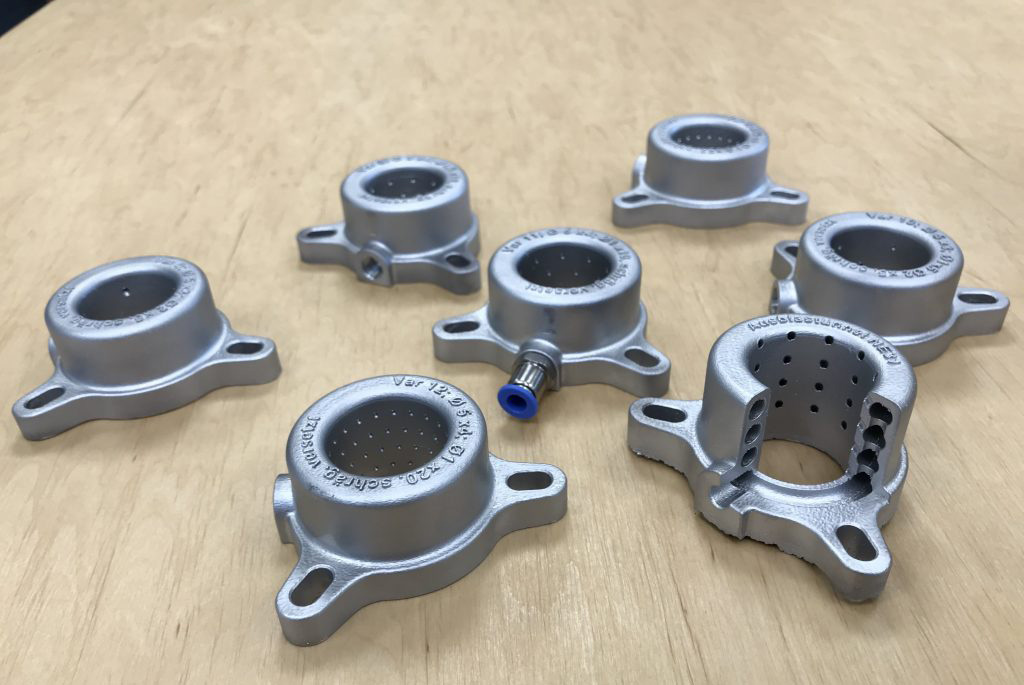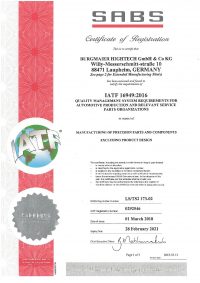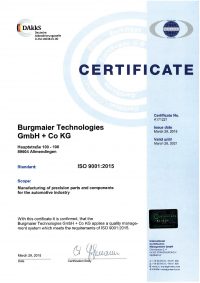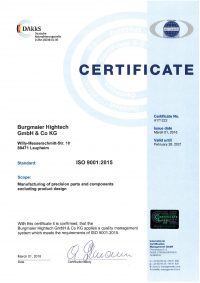In the production of valve sleeves, many chips fly during machining. If these are not blown away properly, the machine stops and production stops. Why not use the potential of additive manufacturing (AM) and design a component that can handle the task better? What the engineers at BURGMAIER Technologies GmbH & Co KG have achieved is a real AM success story: With the new component, the machine has never stood still again. The company thus saves a high five-figure sum per year.
The State Agency for Lightweight Construction Baden-Württemberg will present this innovation with its ThinKing in March 2020. With this label, Leichtbau BW GmbH will provide a platform for innovative products or services in lightweight construction from Baden-Württemberg every month.
At a glance:
- Degree of utilization increases by seven percent – high five-digit cost savings per year
- Full capacity utilization – no more machine downtime
- Costs for production and development had been amortized within a few days
- Process chain becomes simpler: no washing after machining
“Burgmaier’s example shows why lightweight construction is a key technology that mechanical and plant engineers can no longer ignore,” says Dr. Wolfgang Seeliger, Managing Director of Leichtbau BW GmbH. The new component performs the task much better than the previous solution, creates added value and reduces production costs. The BURGMAIER Technologies GmbH + Co KG produces several million valve sleeves annually by machining. In the multi-spindle lathe, two classic air outlets ensure that chips and oil are blown off the components before a robot automatically transfers the component to an interlinked testing device. “On average, however, the machine stopped five times per shift because not all chips could be removed and the testing device thus stopped the process,” says Ken Krauß, Head of Additive Manufacturing at Burgmaier. In order to reduce scrap and the frequent manual troubleshooting, the Additive Manufacturing team set about designing a blow-out channel. The component must pass through this tunnel after machining. The openings in the channel are intended to ensure that the compressed air reaches the valve sleeves from all sides and that the components are freed of chips without leaving any residue.
Burgmaier has designed a total of six variants of this blow-off nozzle and produced them with the alloy AlSi10Mg on the company’s own printers. Then the field test of the new blow-off nozzles on the machines was due. The result is more than impressive: “We could only manufacture the nozzles using AM due to the geometry. After installation, the machine downtime was reduced to zero. This increased the efficiency of the machine by seven percent,” says Krauß proudly. He expects a high five-figure cost saving per year. “A real competitive advantage and best practice example for the application of additive manufacturing in mechanical engineering,” says Seeliger.
“We have done the math: The costs for the development and manufacture of the blow-off tunnel have paid for themselves within days,” Krauß is pleased to report. In addition, the new blow-off device is significantly quieter than the previous solution. “The cleaning result is also much better. “Not only chips but also oil are removed very well and we can save ourselves the downstream washing cycle”, says Krauß. The component is an improvement for his own machinery. “In our Additive Manufacturing division, we are happy to make our know-how available to develop optimized components for our customers’ machines and systems and to manufacture them using AM,” says Krauß.
BURGMAIER Technologies GmbH + Co KG
The company, based in Allmendingen, is one of the leading manufacturers of precision parts. Over 800 employees work in development, design, production, assembly and quality assurance. According to the company’s own information, about 350,000 parts leave the Burgmaier plants every day – statistically speaking, there are five parts of the company in every European car. The company combines its process knowledge from the subtractive machining of workpieces with additive manufacturing to be able to offer components from a single source. In the Additive Manufacturing division, the family-owned company offers services along the entire AM process chain. www.burgmaier.com
A best-practice example of the potential of lightweight construction and additive manufacturing in mechanical engineering: The 3D printed component for a cutting machine ensures that the machine is used to full capacity and that there are no more failures. Output has thus increased by seven percent and annual savings in the high five-digit range are expected. Source: BURGMAIER Technologies GmbH + Co KG. Reprint free of charge.






